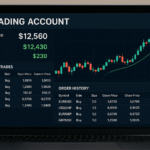The Impact of Economic Indicators on Major Stock Indices

What are economic indicators and why are they important for stock indices?
Economic indicators are like helpful hints about where the economy and stock indices might be going when you look at the markets or examine trading chart patterns. These signs provide us a look at jobs, inflation, growth, and how people spend their money. They are important not only for seeing how the market is moving as a whole, but also for finding setups in trading chart patterns that can help you make trades.
For instance, stock indexes frequently go up when GDP grows quickly, but inflation or rising unemployment could cause them to go down. You may better understand your trade chart patterns—whether you’re looking at reversals, breakouts, or trend continuation setups—by paying attention to how these macro indications play out.
Important Economic Indicators That Affect Major Stock Indices
Let’s look at some of the big ones that move the major indices:
When GDP (Gross Domestic Product) goes up, the stock market usually celebrates. It means that businesses are growing, profits are going up, and people are feeling good about the future. This is commonly shown by indexes that are going higher.
Inflation and Interest Rates: Central banks are directly affected by inflation measures like the CPI and PPI. When inflation is high, rates may go up, which usually slows down the markets. On the other side, low or falling inflation can make green candles appear on your charts.
Employment Data (Jobs Report): Positive job growth makes people spend more money, which typically makes bullish chart setups more stronger. But weak job figures might cause bearish-looking breakdowns or range shifts.
Retail Sales and Consumer Confidence: When people spend more, businesses make more money. When retail sales are strong, indexes frequently have positive chart momentum.
Health in manufacturing frequently leads to stronger indices, such as PMI and IPI. When indices are generating breakouts or corrections, these indicators can be early signs.
Leading Economic Index (LEI) and Coincident Index (CEI): These composite metrics use several data to predict or confirm the direction of the economy. A dropping LEI could be a sign that the index is about to correct itself, while a rising CEI could mean that strength will last.
Durable Goods Orders: An increase means that there is solid demand in the industrial sector, which frequently supports bullish trends in key indices.
Investor Sentiment and Volatility (VIX): The “fear gauge.” High VIX levels frequently mean that major charts are going down, while low readings mean that confidence is growing and ranges are getting bigger.
How These Indicators Really Show Up in Patterns on Trading Charts
When you look at trading chart patterns, these economic signals typically show themselves in small ways:
Strong increase in GDP, retail sales, or manufacturing often happens at the same time as breakouts and trend continuations.
After bad news about inflation or sluggish job growth, reversals or bearish formations could happen.
Consolidations or sideways ranges might show ambiguous signals, such when CPI and retail data don’t agree.
Volatility spikes, such enormous wick candles or wide-range bars, sometimes happen after surprise indicator releases or dramatic changes in the economy.
When you know how economic indicators affect the structure of the market, you can line up your trading chart patterns with macro momentum, which gives you an edge in predicting what will happen next.
Advice for Traders Who Use These Insights
Follow the calendar for data: You should know when GDP, CPI, PPI, retail sales, jobs statistics, or PMI numbers go down. These are important times that can change indices and chart patterns.
Use a trustworthy trading account so you can move quickly when huge patterns appear shortly after economic data comes out.
Combine macro with technical: If GDP is going up and your chart shows a bullish breakout, that’s a strong combination. If you detect a bearish reversal forming and inflation surprises are coming, it’s important to think about how to protect yourself.
Check the LEI signals: These composite indexes might help you figure out if a breakout will last or if it might turn around.
Be careful with risk when indicators come out. Volatility can go up, so make your entries tighter, apply stop losses, or wait for confirmation in the charts after the release.
Last Thoughts
Economic indicators are like the people that work behind the scenes of the market. When you pay attention to them, your trading chart patterns become clearer and more useful. A good trading account lets you in as soon as the next move starts to take shape. Knowing what’s going on in the big picture provides you the confidence to trade better, whether you’re riding a breakout, fading a reversal, or catching a range move.
Next time you observe a bullish flag or a head-and-shoulders pattern, ask yourself what the economic data imply. Aligning macro context with chart settings helps you remain ahead of the game.






